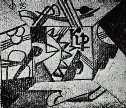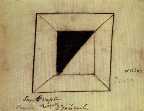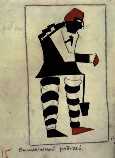 |
Vol 1, No 3, 12 July 1999
|
|
|
 T H E A T R E:
T H E A T R E:
Zaum and Sun: The 'first Futurist opera' revisited Isobel Hunter When the Futurist opera Victory over the Sun was first performed in St Petersburg in 1913, the audience reacted violently to the chaos of Mikhail Matiushin's music, Alexei Kruchenykh's nonsensical text and Kazimir Malevich's costume. Subsequent critics and historians have reacted in a similarly negative fashion, and although the work is referred to often in histories of the Russian Futurist movement, it is largely on account of Malevich's contribution. His costumes were composed of bright geometric shapes and the backdrop included a black square - together these elements mark his first experiments with the technique of 'suprematism', which he was to continue to develop over the next two years. In 1915 at the 0.10 Exhibition, Malevich exhibited a large series of suprematist canvases composed of planes of colour, with his Black Square holding centre place, hung like an icon in the corner of the room.
Since drawings of Malevich's costumes and set survive, his work for Victory Over the Sun receives far more attention than the text and music, which only survive in fragmentary form and are not generally recognised as having such significant influence on later artistic experiment. In this light, it is brave that Julia Hollander chose not to attempt a recreation of Malevich's work, but instead branched out with new sets and costumes, enhanced with modern lighting techniques, in an attempt to create a performance of contemporary significance. However, it is debatable whether the work itself should be accorded serious purpose, or whether, as was the overall effect with this production, it should just be enjoyed as a lively piece of fun. In Victory Over the Sun, the sun, representative of the decadent past, is torn down from the sky, locked in a concrete box, and given a funeral by the Strong Men of the Future. The Traveller in Time appears to declare the future is masculine and that all people will look happy, although happiness itself will no longer exists. Meanwhile, the Man with Bad Intentions wages war and the terrified Fat Man finds himself unable to understand the modern world. The opera ends as an aeroplane crashes into the stage. In her production, Julia Hollander attempts to ascribe contemporary significance to this confusing melange of events. In her programme notes she writes of the similarity between 1913 and 1999: in 1913, Europe teetered on the brink of the First World War, and with the current conflict in the Balkans, Europe could be facing another major war. She appears to read the work as a dark prophecy of trouble to come. However, the original performance was far more about rejection of the secure past than of a fear of the future: the sun itself was a favourite Symbolist motif, and hence suitable as a target for Futurist attack. A more appropriate approach is El Lissitzky's 1923 analysis of the work as a celebration of man's technological capabilities: 'the sun as the expression of old world energy is torn down from the heavens by modern man, who by virtue of his technological superiority creates his own energy source.' This understanding of the work seems closer to the original spirit than Hollander's fear of the future. Nevertheless, her production does work very well, and the set, music, lighting, costume and acting manage to combine into a well-paced and energetic whole. Thus, although the audience at the Barbican Centre was confused and mystified for much of the performance, the experience was certainly exciting. Radically over-turning the usual use of the theatre space, the performers occupied the ranks of seats, while the audience was corralled into the stage area in the centre, around which the action whirled. As the performance proceeded, the division between audience and performer was eroded as the actors rampaged through the audience, shoved them out the way, cajoled them into wearing paper masks and dancing in circles. The audience reacted with good humour, despite, rather ironically, being representative of the usual Barbican audience: composed largely of the type of bourgeoisie that the Futurists aimed at with their 1913 manifesto 'A Slap in the Face of Public Taste'. As only fragments of Matiushin's music survive, the score for the new production was largely rewritten by Jay Arden. His string trio proved one of the highlights of the whole performance. Perhaps in homage to Alexander Scriabin, the trio was accompanied by a laser light show: the beam of the laser bending and twisting in response to the music. The costumes were a pleasing retro-mix of the overalls worn by early 1980s synthesizer bands and Popova's functional sport clothing of the 1920s. Unlike Malevich's original designs, these costumes allowed the actors the freedom of movement, which they needed to climb over the seats, charge through the audience and hang upside from ladders and ropes.
The text was overshadowed by the music, costumes and action; perhaps as in the original performance, after which critics complained that most of the dialogue had been inaudible. Kruchenykh wrote much of the text in zaum, or transrational language, in which Russian was broken down into its fundamental sound forms to strip it of precise meaning and to lay bare the deeper and more primitive force of the sounds themselves. Obviously, zaum is untranslatable, so in places the actors spoke the original verses, handing out English equivalents on pieces of paper. In Hollander's performance, words hold centre stage only at a few points: during the - largely rewritten - speeches of the Fat Man and during a rather beautiful and serene sequence about 'carefree goldfish flexing their tails like grateful Turks'. It would have no doubt been helpful if the programme notes had described how much of the original text was used and which parts were rewritten; instead the notes are concerned only with Khlebnikov's work, who wrote only the prologue to the opera and did not contribute anything to the main work because he missed his train on the day he intended to visit Kruchenykh! Khlebnikov's zaum has received scholarly attention, as has his influence on artists including Malevich and Tatlin. In comparison, Kruchenykh is ignored, or as is the case with the programme notes, his linguistic experiments are confused with those of Khlebnikov. It is a shame, because Kruchenykh's urge to find the empty centre of language by stripping it down to its constituent elements is challenging and terrifying. Isobel Hunter, 12 July 1999 Click HERE to see illustrations of Malevich's original set and costume designs. And HERE for more informtaion on events at the Barbican Centre in London.
|
|
![]()
Copyright (c) 1999 - Central Europe Review Internet servis, a.s.
All Rights Reserved

